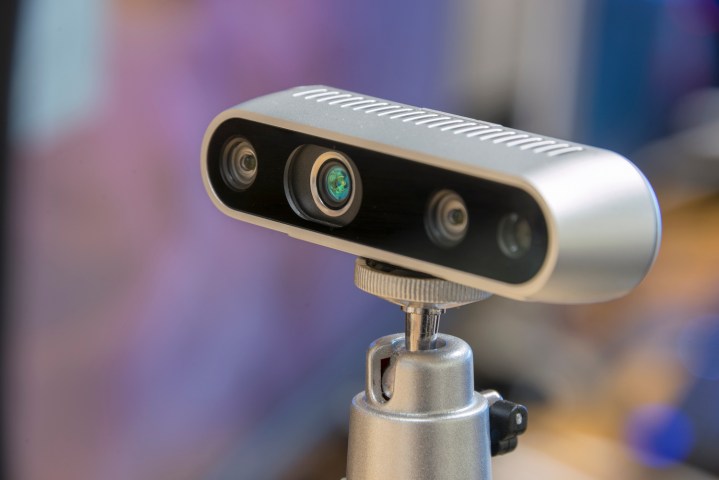In recent years the humble webcam has enjoyed something of a renaissance. Thanks to the proliferation of streaming and vlogging, there’s now a need for better cameras with more high-tech features. Webcam manufacturers have responded by putting out tons of affordable, high-quality cams designed for professional broadcasting use, and companies like Razer are even releasing streamer-centric cams with built in light fixtures.
But Intel has entered the premium-webcam arena with something of an unusual offering, the RealSense D415 and D435 webcams. There’s a bit more to these cameras than meets the eye, though — these guys are depth cameras, meaning they can distinguish you from your background.
Could they be the ultimate solution for streamers? Maybe — but here’s why they probably aren’t ready to take that title.
How they work
Normal webcams just sit on top of your monitor and record visible light, just like the front facing camera on your smartphone. Intel’s RealSense cameras go one step further, they record visible light — and invisible, infrared light. This gives these cameras the ability to create a three dimensional depth map of your surroundings. That’s right: These cams don’t just see you, they know where you are, the dimensions of your surroundings, and how perilously close that soda can is to your keyboard.
Both of these cameras feature the same output resolution and framerate, 1920x1080p at 30 frames-per-second, both feature the same tripod mount underneath the camera body, and they have solid, brushed aluminum bodies. But the similarities end there, internally, the cameras have very different capabilities.
The Intel RealSense D415 is the entry level model, starting at $149 and has a slightly pared down feature set than its more expensive cousin, the RealSense D435. More significantly, the depth sensor inside the RealSense D415 is limited to a 69 degree field of view horizontally, and ten meters of depth, which is a fairly narrow range. But it’s all right if you’re just going to be sitting right in front of it for a Twitch, YouTube or Mixer stream.
RealSense offers an intriguing glimpse at the future of depth tracking, but that’s about it.
Sure all that sounds cool, but why would one of these cameras, in the future, be worth buying? Well, like we stated earlier, the first thing that comes to mind would for professional streamers. With the right software, one of these cameras could make your surroundings disappear without the use of a green screen.
Instead, the cameras would use their depth sensors, IR blasters, and digital witchcraft to separate you from your background. Sure beats wrestling with a green sheet or collapsible greenscreen you’ll have to clamp to some kind of stand behind you.
Plus, the Intel page describing the capabilities of the cameras strongly suggests that they could be used for some really cool gesture tracking. Now have we seen them do any of these things in our time with the devices in our office? Unfortunately, not at all.
The bottom line
Here’s the truth: If you bought one of these cool cameras today, you’d end up with a device that doesn’t really do much of anything. Right now, its software suite is literally just a development kit. So, to use them in any capacity, you would have to write the software yourself.
Let’s be very up front about something: These cameras are probably not for you. If you want a new webcam for streaming, look elsewhere, these things are cool but they’re essentially just fancy development tools. I know, we were disappointed too. These cams are just development tools, and for most people, they’re just empty promises at this point.
They’re designed for developers who want to use depth sensing for a variety of different applications — all of which will not be ready to test out for quite some time. That said, we might get a closer look at Intel’s plans for the RealSense depth cameras at CES this year, so stay tuned.
Thing is, there’s a lot of cool stuff these cameras could do, but not very much they can do currently. Because of the impressive technology they’re built on, they could, for instance, be used for gesture tracking, and all kinds of Minority Report-style interactivity. There are even some apps you can download from Intel’s GitHub to test these features out. And yes, that’s right, this project is so early in its development that the software it uses is all available on GitHub rather than some clean and tidy Intel-hosted installer file.
These two cameras offer an intriguing glimpse at the future of depth tracking, but that’s about it. If you’re a developer, head over to Intel’s developer portal for the RealSense cameras and see if they might be right for your project, but for everyone else, there’s nothing to see here folks. These aren’t products, they’re tools.







